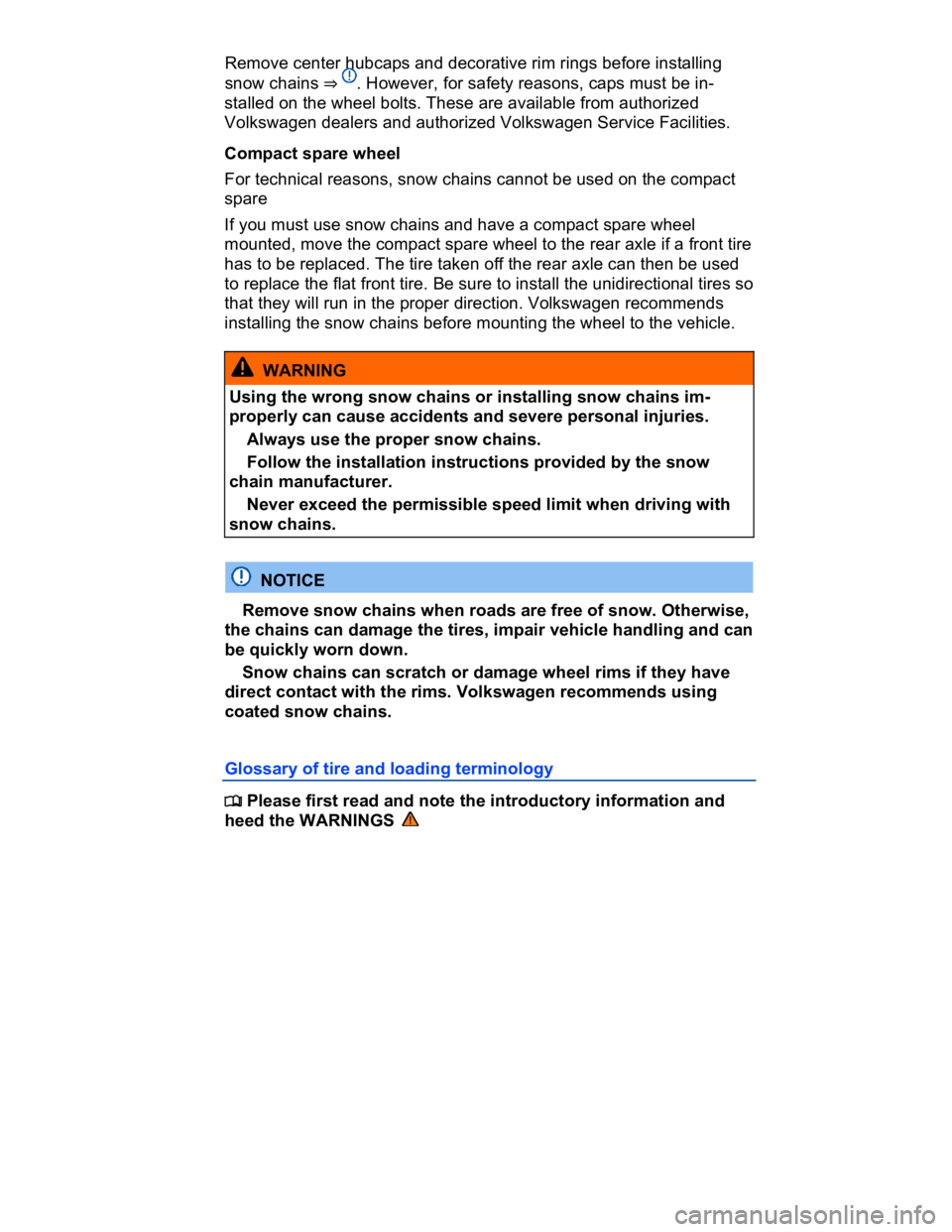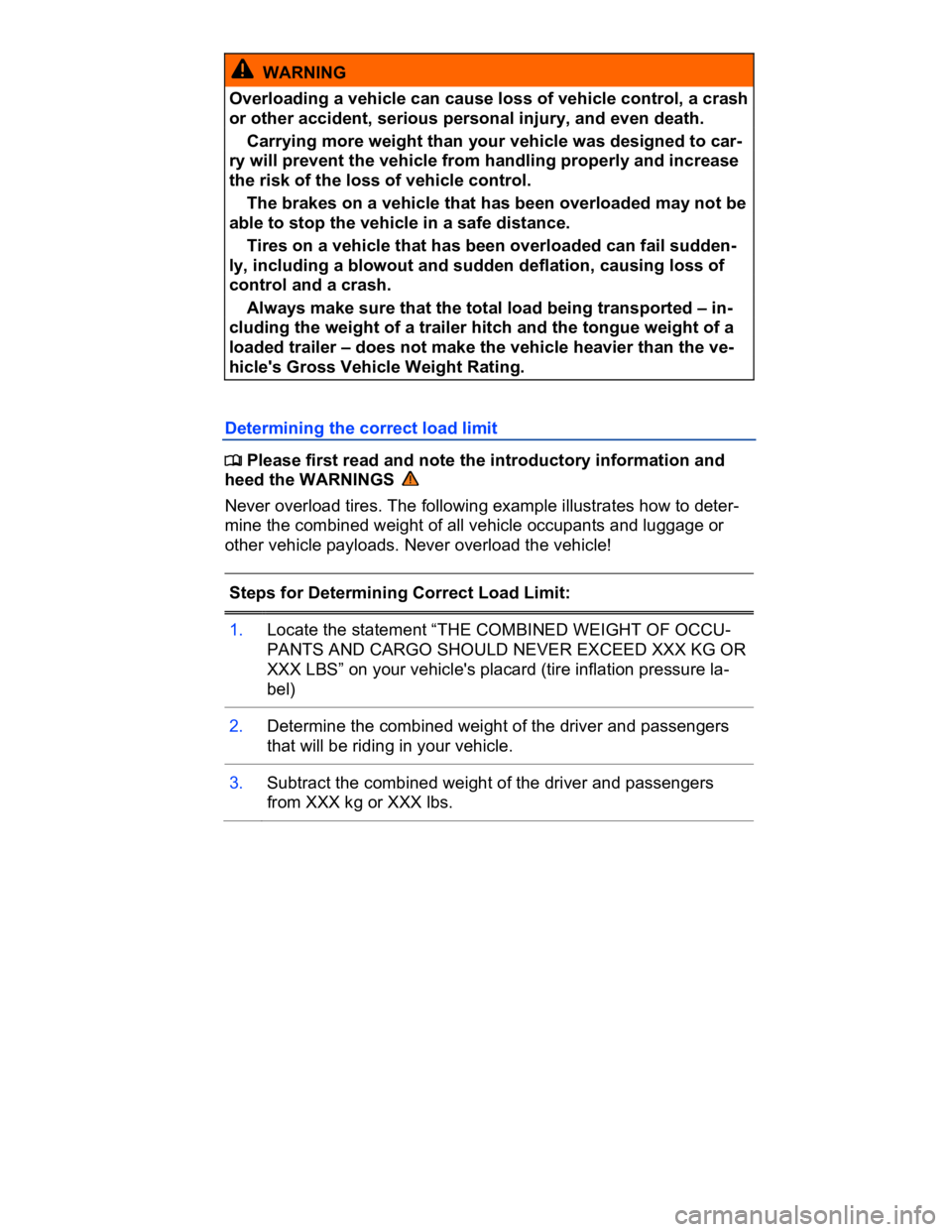2013 VOLKSWAGEN CC flat tire
[x] Cancel search: flat tirePage 254 of 578

Install summer tires promptly in the spring. Summer tires offer
better handling characteristics for temperatures above +45 °F (+7 °C).
They are quieter, do not wear as quickly, and reduce fuel consump-
tion.
If factory-installed wheels and/or tires are replaced when in-
stalling winter tires, make sure that the wheels are equipped with
sensors that are compatible with the factory-installed Tire Pressure
Monitoring System and that the tires are also compatible with the sys-
tem. If new tires are not identical to those that were removed and re-
quire different cold tire inflation pressure, the tire inflation pressure
values must be reprogrammed for the TPMS. Please see your author-
ized Volkswagen dealer or authorized Volkswagen Service Facility ⇒
The Tire Pressure Monitoring System must be recalibrated whenever
you remove and remount or change any wheel or tire on the vehicle,
even if the reinstalled or replacement wheels and tires are identical to
those that were removed and even if the tire pressure does not
change.
If necessary, ask your authorized Volkswagen dealer or author-
ized Volkswagen Service Facility about permissible winter tire dimen-
sions.
Snow chains
�
Page 255 of 578

Remove center hubcaps and decorative rim rings before installing
snow chains ⇒ . However, for safety reasons, caps must be in-
stalled on the wheel bolts. These are available from authorized
Volkswagen dealers and authorized Volkswagen Service Facilities.
Compact spare wheel
For technical reasons, snow chains cannot be used on the compact
spare
If you must use snow chains and have a compact spare wheel
mounted, move the compact spare wheel to the rear axle if a front tire
has to be replaced. The tire taken off the rear axle can then be used
to replace the flat front tire. Be sure to install the unidirectional tires so
that they will run in the proper direction. Volkswagen recommends
installing the snow chains before mounting the wheel to the vehicle.
WARNING
Using the wrong snow chains or installing snow chains im-
properly can cause accidents and severe personal injuries.
� Always use the proper snow chains.
� Follow the installation instructions provided by the snow
chain manufacturer.
� Never exceed the permissible speed limit when driving with
snow chains.
NOTICE
� Remove snow chains when roads are free of snow. Otherwise,
the chains can damage the tires, impair vehicle handling and can
be quickly worn down.
� Snow chains can scratch or damage wheel rims if they have
direct contact with the rims. Volkswagen recommends using
coated snow chains.
Glossary of tire and loading terminology
�
Page 256 of 578

Accessory weight
The combined weight (in excess of those standard items which may
be replaced) of automatic transmission, electro-mechanical power
steering, power brakes, power windows, power seats, radio, and
heater, to the extent that these items are available as factory-installed
equipment (whether installed or not).
Aspect ratio
The ratio of sidewall height to tire width, expressed as a percentage.
A number of 70 (0.7:1 or 70%) or lower indicates a low-profile tire with
a shorter sidewall for improved steering response and better overall
handling on dry pavement.
Bead
The part of a tire made of steel wires, wrapped or reinforced by ply
cords, with the shape and structure to ensure proper fit to the wheel
rim.
Bead separation
A breakdown of the bond between components in the bead.
Carcass
The tire structure, except tread and sidewall rubber which, when in-
flated, bears the load.
Chunking
The breaking away of pieces of the tread or sidewall.
Cord
The strands of material forming the plies in the tire.
Cord separation
The parting of cords from adjacent rubber compounds.
Cracking
Any parting within the tread, sidewall, or inner liner of the tire extend-
ing to cord material.
Cold tire inflation pressure
The tire pressure recommended by the vehicle manufacturer for a tire
of a specified size that has not been driven for more than a couple of
Page 257 of 578

miles (kilometers) at low speeds in the 3 hour period before the tire
pressure is measured or adjusted.
Curb weight
The weight of a motor vehicle with standard equipment including the
maximum capacity of fuel, oil, and coolant, air conditioner, and addi-
tional weight of optional equipment.
Extra load tire
A tire designed to operate at higher loads and at higher inflation pres-
sures than the corresponding standard tire.
Gross Axle Weight Rating (GAWR)
The load-carrying capacity of a single axle system, measured where
the tire contacts the ground.
Gross Vehicle Weight Rating (GVWR)
The maximum loaded weight of the vehicle.
Groove
The space between 2 adjacent tread ribs.
Load rating (code)
The maximum load that a tire is rated to carry for a given inflation
pressure. You may not find this information on all tires because it is
not required by law.
Maximum load rating
The load rating for a tire at the maximum permissible inflation pres-
sure for that tire.
Maximum loaded vehicle weight
The total of:
� Curb weight.
� Accessory weight.
� Vehicle capacity weight.
� Production options weight.
Maximum (permissible) inflation pressure
The maximum cold inflation pressure to which a tire may be inflated.
Also called “maximum inflation pressure.”
Page 258 of 578

Normal occupant weight
Means 150 lbs (68 kilograms) times the number of occupants seated
in the vehicle up to the total seating capacity of your vehicle.
Occupant distribution
The placement of passengers in a vehicle.
Outer diameter
The diameter of a new, properly inflated tire.
Overall width
Total width measured at the exterior sidewalls of an inflated tire, in-
cluding the additional width of labeling, decorations, or protective
bands or ribs.
Passenger car tire
A tire intended for use on passenger cars, multipurpose passenger
vehicles, and trucks, that have a gross vehicle weight rating (GVWR)
of 10,000 pounds or less.
Ply
A layer of rubber-coated parallel cords.
Ply separation
A parting of rubber compound between adjacent plies.
Pneumatic tire
A mechanical device made of rubber, chemicals, fabric, and steel or
other materials, that, when mounted on an automotive wheel, pro-
vides the traction and contains the gas or fluid that sustains the load.
Production options weight
The combined weight of installed regular production options weighing
over 5 lbs (2.3 kg) more than the standard items they replace, and not
previously considered as curb weight or accessory weight. These
include, for example, heavy-duty brakes, ride levelers, roof rack,
heavy-duty battery, and special trim.
Radial ply tires
A pneumatic tire in which the ply cords that extend to the beads are
laid at substantially 90 degrees to the centerline of the tread.
Page 259 of 578

Recommended inflation pressure
The tire pressure recommended by the vehicle manufacturer for a tire
of a specified size that has not been driven for more than a couple of
miles (kilometers) at low speeds in the 3 hour period before the tire
pressure is measured or adjusted.
Reinforced tire
A tire designed to operate at higher loads and at higher inflation pres-
sures than the corresponding standard tire.
Rim
The outer edge of a wheel upon which the tire beads are seated.
Rim diameter
The nominal diameter of the wheel's tire bead seating surface. If you
change your wheel size, to wheels of a different diameter, you will
have to purchase new tires to match the new wheels.
Rim size
Designation means rim diameter and width.
Rim type designation
The industry or manufacturer's designation for a rim by style or code.
Rim width
The nominal distance between wheel rim flanges.
Section width
The linear distance between the exteriors of the sidewalls of an inflat-
ed tire, excluding elevations due to labeling decoration, or protective
bands.
Sidewall
The portion of a tire between the bead and the tread.
Sidewall separation
The parting of the rubber compound from the cord material in the
sidewall.
Page 260 of 578

Speed rating (letter code)
A standardized letter code indicating the maximum speed at which a
tire is designed to be driven for extended periods of time. The ratings
range from 93 mph or 150 km/h (“P”) to 186 mph or (300 km/h) “Y”.
The speed rating letter code, where applicable, is molded on the tire
sidewall. You may not find this information on all tires because it is
not required by law.
Tire Pressure Monitoring System
A system that detects when at least one of a vehicle's tires is underin-
flated and illuminates a low tire-pressure warning light.
Tread
The portion of a tire that normally touches the road.
Tread rib
A tread section running circumferentially around a tire.
Tread separation
Tire failure caused by the tread pulling away from the tire carcass.
Tread wear indicators (TWI)
Raised areas within the main tread grooves that show, visually, when
tires are worn and near the end of their useful life ⇒ page 261.
Uniform Tire Quality Grading (UTQG)
A tire information system developed by the U.S. National Highway
Traffic Safety Administration (NHTSA) that is designed to help buyers
compare tires. UTQG is not a safety rating, nor is it a guarantee that a
tire will last for a certain number of miles or perform a certain way. It
gives tire buyers more information to compare with factors such as
price, brand loyalty and dealer recommendations. Under UTQG, tires
are graded by the tire manufacturers in 3 areas: tread wear, traction
and temperature resistance. UTQG information is molded into the tire
sidewalls.
U.S. DOT Tire Identification Number (TIN)
A tire's serial number. It begins with the letters “DOT” (“Department of
Transportation”) and indicates that the tire meets all federal stand-
ards. The next 2 numbers or letters indicate the plant where the tire
Page 263 of 578

WARNING
Overloading a vehicle can cause loss of vehicle control, a crash
or other accident, serious personal injury, and even death.
� Carrying more weight than your vehicle was designed to car-
ry will prevent the vehicle from handling properly and increase
the risk of the loss of vehicle control.
� The brakes on a vehicle that has been overloaded may not be
able to stop the vehicle in a safe distance.
� Tires on a vehicle that has been overloaded can fail sudden-
ly, including a blowout and sudden deflation, causing loss of
control and a crash.
� Always make sure that the total load being transported – in-
cluding the weight of a trailer hitch and the tongue weight of a
loaded trailer – does not make the vehicle heavier than the ve-
hicle's Gross Vehicle Weight Rating.
Determining the correct load limit
�